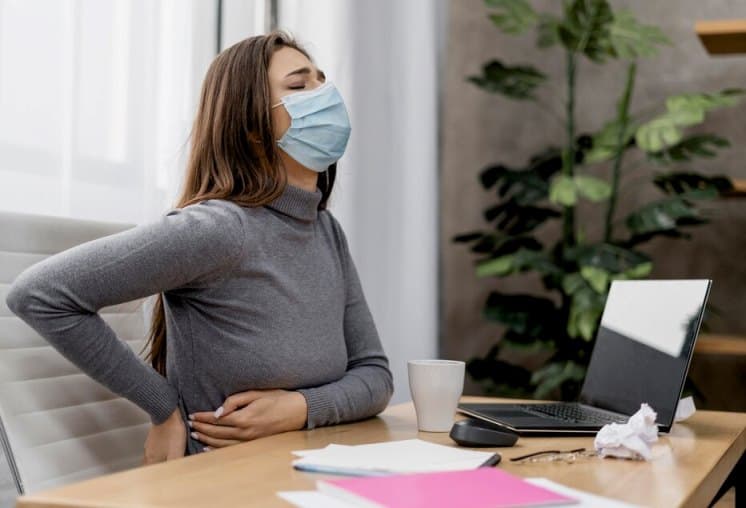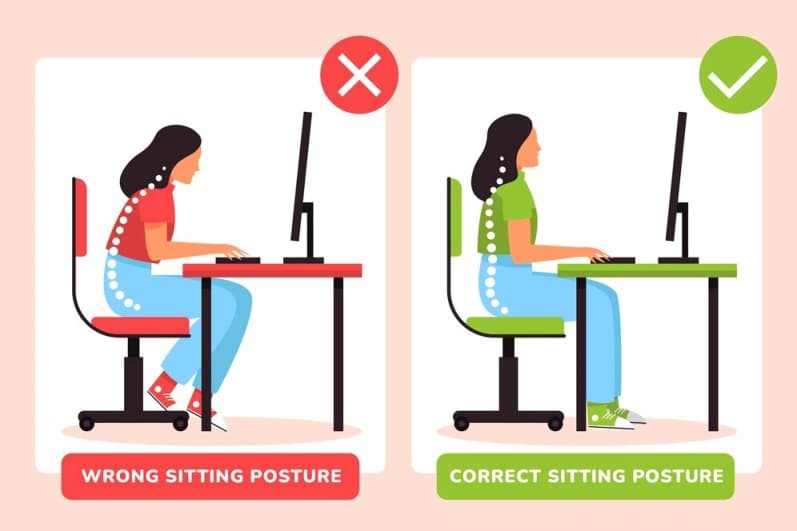In our modern, sedentary lifestyle, lower back pain stemming from prolonged sitting has emerged as a significant concern. Whether it’s hours spent at the office desk or relaxing in front of screens during leisure time, many individuals experience discomfort and pain in the lower back region.
Therefore, we want to address this frequent issue in this thorough guide by offering practical methods and tactics to reduce and prevent lower back pain caused by extended periods of sitting.
What Makes Sitting Uncomfortable For Your Lower Back?
Lower back pain when sitting can stem from various factors, each contributing to discomfort and strain on the lumbar region. One common cause is poor posture, where sitting for prolonged periods without proper support or alignment can lead to undue pressure on the spine and surrounding muscles. Slouching, hunching forward, or leaning to one side can exacerbate this issue, placing added stress on the lower back muscles and ligaments.
Read Also: Why Does My Neck Hurt When I Turn My Head?
Muscle imbalances also play a significant role in contributing to lower back pain when sitting. Weak core muscles, specifically the abdominal and lower back muscles, fail to provide adequate support for the spine, leading to instability and discomfort. Conversely, tight hip flexors and hamstrings can pull the pelvis out of alignment, further exacerbating lower back pain.
Additionally, sedentary lifestyle habits contribute to lower back pain when sitting. Lack of regular physical activity and prolonged periods of sitting weaken the muscles that support the spine, leading to stiffness and decreased flexibility. Over time, this can result in chronic pain and discomfort, making it challenging to sit for extended periods without experiencing discomfort.
Furthermore, poor ergonomics in the workplace or home environment can exacerbate lower back pain when sitting. Chairs that lack proper lumbar support or are improperly adjusted can force the spine into unnatural positions, increasing the risk of strain and injury. Similarly, using a desk or workstation that is too high or too low can lead to awkward postures, placing undue stress on the lower back.
Lastly, underlying medical conditions such as herniated discs, spinal stenosis, or degenerative disc disease can contribute to lower back pain when sitting. These conditions may cause compression of the spinal nerves or inflammation of the surrounding tissues, resulting in persistent discomfort and reduced mobility.
Strategies To Prevent Lower Back Pain When Sitting
Lower back pain is a common issue, especially for those who spend long hours sitting at desks or in front of computers. However, by implementing the right strategies, you can prevent or alleviate discomfort and maintain a healthy spine. Here are some effective ways to prevent lower back pain when sitting:
Ergonomic Workspace Setup
Creating an ergonomic workspace is crucial in mitigating the risk of lower back pain. Start by ensuring that your chair provides proper lumbar support, maintaining the natural curve of your spine.
Adjust the height of your chair so that your feet rest flat on the floor and your knees are at a 90-degree angle. Position your computer monitor at eye level to avoid straining your neck and upper back.
Additionally, using a chair mat can also help in optimizing your workspace ergonomics. A chair mat provides a smooth surface and protects flooring, reducing friction and making it easier to move your chair without straining your lower back. By ensuring effortless movement and proper alignment, a chair mat complements the ergonomic setup, contributing to a more comfortable and supportive environment for prolonged sitting.
Incorporating Movement Breaks
One of the most effective ways to combat lower back pain from sitting is by incorporating regular movement breaks into your routine. Set a timer to remind yourself to stand up, stretch, and walk around for a few minutes every hour.
Simple stretches targeting the lower back, such as the cat-cow stretch or knee-to-chest stretch, can help alleviate tension and improve flexibility.
Strengthening Core Muscles
Core muscles play a significant role in supporting the spine and maintaining proper posture. Incorporating exercises that target the core, such as planks, bridges, and bird dogs, can help strengthen these muscles and reduce the risk of lower back pain. Aim to include core workouts in your fitness routine at least three times a week.
Practicing Good Posture
Maintaining good posture is essential for preventing lower back pain. When sitting, ensure that your shoulders are relaxed, and your spine is in a neutral position, with the natural curves supported.
Avoid slouching or leaning forward, as this places unnecessary strain on the lower back. Consider using a lumbar support cushion to help maintain proper posture throughout the day.
Investing in a Standing Desk
Standing desks offer a viable solution for reducing the amount of time spent sitting and alleviating lower back pain. Alternating between sitting and standing throughout the day can help improve circulation, reduce muscle stiffness, and promote better posture.
If possible, invest in an adjustable standing desk that allows you to easily transition between sitting and standing positions.
Check More: How to know if we have osteoarthritis or arthritis?
Utilizing Heat and Cold Therapy
Heat and cold therapy can provide temporary relief from lower back pain by reducing inflammation and relaxing tense muscles. Apply a heating pad or warm compress to the affected area for 15-20 minutes at a time to soothe muscle stiffness and increase blood flow. Alternatively, cold packs can help numb the area and reduce pain and swelling.
Seeking Professional Help
If lower back pain persists despite implementing these strategies, it may be beneficial to seek professional help from a healthcare provider or physical therapist. They can assess your condition, provide personalized recommendations, and offer treatments such as manual therapy, acupuncture, or customized exercise programs tailored to your needs.
The Takeaway
Lower back pain from sitting shouldn’t hold you back from enjoying life to the fullest. By implementing these proactive measures, you can alleviate discomfort, improve your posture, and prevent future issues.
Always pay attention to your body, prioritize movement and proper ergonomics, and seek professional guidance if needed. Together, we can empower ourselves to live healthier, pain-free lives.

